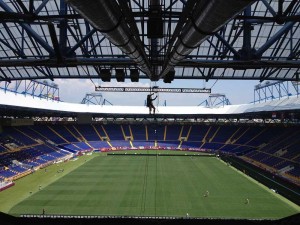 Veteran rock climber Chris Watford and his rigging team at ClimbSouth specialize in installing Camera Corps’ Q-Ball robotic camera systems in difficult and hard to reach locations that can only be reached by trained climbers. The company has installed camera systems around the world in everything from mountain passes and trees in the jungle to major cities and sporting event stadiums’ building roofs for broadcast and commercial productions.
Veteran rock climber Chris Watford and his rigging team at ClimbSouth specialize in installing Camera Corps’ Q-Ball robotic camera systems in difficult and hard to reach locations that can only be reached by trained climbers. The company has installed camera systems around the world in everything from mountain passes and trees in the jungle to major cities and sporting event stadiums’ building roofs for broadcast and commercial productions.
The rugged design of Q-Ball makes these nearly impossible installations possible for ClimbSouth and its expert riggers.
“I have been fortunate enough to work on specialized video installations for over 14 years,” said Watford. “I watched the development of Q-Ball from the beginning, knowing that this would become a significant, sought after production tool for the broadcast industry. Since the Q-Ball’s introduction, the ClimbSouth team has encountered installations that include flying Q-Ball cameras over public squares, neatly from historic buildings and stadium flying for sports events. This work is not for the shy and you certainly do not want to revisit a location because something is not functioning properly, so quality is a key factor. The Q-Ball has a proven track record for spot-on performance.”
ClimbSouth has put together a team of up to eight professionals capable of traveling around the globe at a moment’s notice. One common thread running through each installation is the amount of time it takes to successfully mount and test each camera. With the advent of Q-Ball, the installation time has dropped considerably, which helps to streamline the process.
“Q-Ball has definitely cut the time for high-angle applications in half over flying more traditional POV cameras,” explained Watford. “The systems are light so they can easily be carried up to the highest perch without causing stress on the climber. Further, Q-Ball is a sleek system that doesn’t require external interface boxes and ancillary equipment, meaning that it does not come with a tangle of wires. This is another time saving factor when climbing up a mountain cliff or a stadium support for that perfect shot.”
According to Watford, placing a camera system in a high location, such as on a high beam or hanging on a harness in midair, presents a number of challenges for the team because they need a place to set cables, power and interface boxes. This has always been an issue with larger camera systems in terms of how to mount the supplementary equipment, so that it stays up safely and doesn’t fall on the crowd below.
A compact, weather-resistant HD/SD remotely controlled camera, Q-Ball features an integral 10-times-zoom optical lens and smooth-accelerating pan/tilt motors. Housed in a robust 115-mm diameter aluminum sphere, the Q-Ball camera has a two-megapixel CMOS sensor and is capable of operating in daylight or with infrared illumination. It delivers 1080I/720P high definition or 625/525 standard definition imagery at 50- or 59.94-Hz refresh rates.
“Q-Ball cleans up the installation and we can get the job done quickly, which saves on production time,” added Watford. “The Q-Ball also provides a great, clean picture and has become the go-to camera for special and spectacular shots.”





